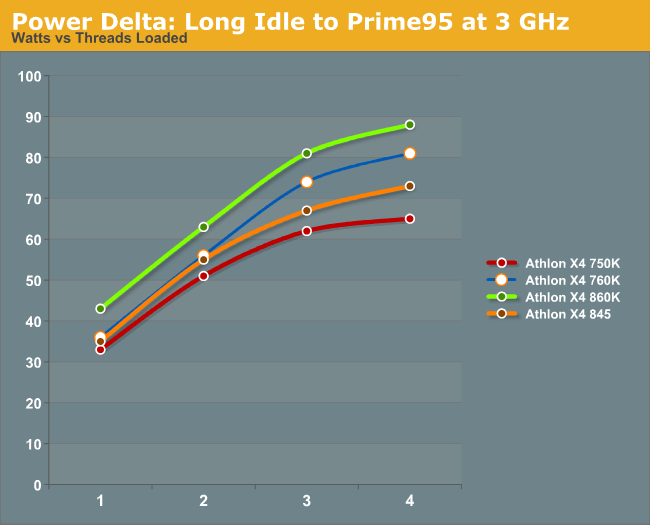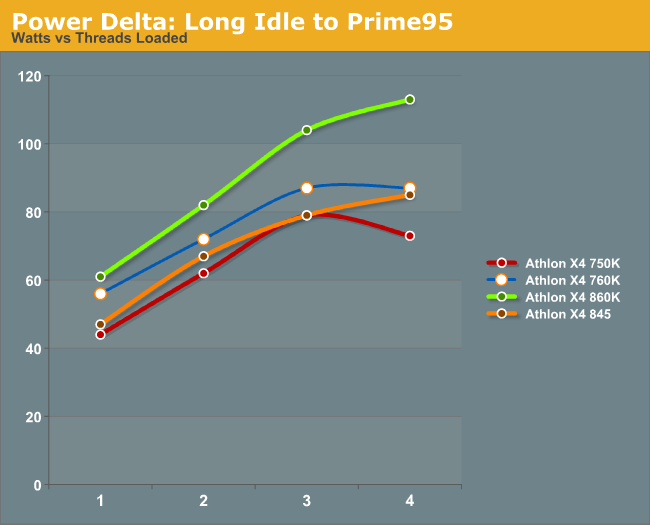AMD Carrizo Part 2: A Generational Deep Dive into the Athlon X4 845 at $70
by Ian Cutress on July 14, 2016 9:00 AM ESTPower Consumption
Power consumption was tested on the system while in a single MSI GTX 770 Lightning configuration with a wall meter connected to the power supply. This power supply is 80PLUS rated, and as I am in the UK on a 230-240 V supply, leads to ~75% efficiency > 50W, and 90%+ efficiency at 250W, suitable for both idle and multi-GPU loading. This method of power reading allows us to compare the power management of the UEFI and the board to supply components with power under load, and includes typical PSU losses due to efficiency.
Our Power Consumption tests have changed slightly since our last review as we are testing out new ways to represent the power used by the CPU and the system. The current three standard tests start with a system at long idle, meaning that the OS turns off the monitor and enters a lower power state without going into S3. We then move into a standard idle state on the desktop, with no software running but the desktop on display. The system is then moved into high performance mode, and we run a one-minute OCCT test to identify peak power consumption.
Due to extended requests, our power consumption numbers also use Prime95 to load the system. We use Prime95's peak power consumption mode, testing 1/2/3/4 thread consumption at the wall with our power meter. P95 hits the peak power relatively quickly, making this a straightforward test to include. For CPUs above 4 threads, we typically manage powers of two, half the CPU, and the full CPU to get an accurate picture.
For this review, we performed the power analysis for all four main CPUs at the 3 GHz frequency (using automatic voltage on the motherboard), as well as at stock frequencies. The values shown are delta values to the long idle power consumption, due to power delivery variations.
Generational Power Consumption at 3 GHz
All four processors have a 2-3W difference moving from a long idle to an idle state, however it is clear that our Carrizo CPU, which we stated is well outside its normal efficiency window at the beginning of this review, has a very good response during OCCT loading.

These results are within 3-4W of the full loading provided by Prime95 as well. If we analyze the per core jumps from moving up the threads using Prime95, there are some interesting numbers to pick out.

All the processors increase their power consumption by ~20W when both modules are loaded, when moving from 1 core loading to 2 core loading. When moving to 3/4 core loading, it is obvious that as both modules are already running at high frequency, a smaller amount of power is needed for each to enable the second thread.
Power Consumption at Stock
For those keeping track, we were not able to source identical TDP rated processors for this test. While the Carrizo based Athlon is 65W, the other processors are at the 95W/100W level. This makes total power consumption numbers relatively processional, and it becomes interesting looking into how close each processor gets to its TDP.
In our testing, the X4 845 seems to go beyond its 65W TDP, pushing almost another 9W through our power meter. This is only 8W away from the X4 750K, which should be 35W ahead. However, it would seem that for the X4 845, P95 draws an extra 15W compared to OCCT, but for the X4 750K, it draws 10W less, showing how difficult it can be to retain consistency. It is worth noting that TDP ratings are difficult to interpret in this way - the processors coming out of the fabs will have a statistical variation to their operating voltage, and this differs between samples. A good sample of a high TDP compared to a bad sample of a low TDP might seem to generate an interesting story, however without having access to several dozen units it can be strained to draw many conclusions.

Looking at the Prime95 core-loading numbers, we see a similar pattern to what happened at 3 GHz, despite the X4 760K getting the same power reading for 3/4 core loading and the X4 750K actually decreasing in power with four loaded threads.










131 Comments
View All Comments
Peichen - Thursday, July 14, 2016 - link
I stopped reading at the messy chart where Athlon X4 750 is available from 2 µArch and there is no science to naming. AMD's CPU division was a bigger failure than its GPU division and it still it. I used to have 3 AMD systems at the same time back in 2005 but have steadily moved away and was considering replacing the last AMD system (Phenom II 840) using Prime Day sales.Ian Cutress - Thursday, July 14, 2016 - link
The 750 and 750K are two different SKUs. As mentioned, trying to find the 750 at retail (and in stock) is *really difficult*, and I'd probably point to it being an OEM-only SKU for a certain design. If anyone has a 750/can find one, let me know.artk2219 - Wednesday, July 20, 2016 - link
I found a link for one, but I think its just an OEM one, and it's from Aliexpress, so it may take a while to get to you. I hope I could help!http://www.aliexpress.com/item/AMD-Athlon-X4-750-A...
http://www.cpu-world.com/CPUs/Bulldozer/AMD-Athlon...
jefeweiss - Thursday, July 14, 2016 - link
I don't think poignant is the word you are looking for here. That would be something that makes you very sad, or emotionally touches you deeply.wallysb01 - Thursday, July 14, 2016 - link
I guess I don't totally understand the comparison to the G3258. I know its a fairly popular processor (I have its non-overclockable little brother, the G3250, and love it in a simple home office set up that I use occasionally for light gaming too). However, its 2 years old. Where is the G4500 or G4520? Supposedly the skylake Pentium would be about 10% faster than haswell, no? And with some perf/W gains too?Speaking of which, where's the comparison to Intel in the power consumption? Do I just not want to see that? If in these multithreaded tasks the 845 is chugging along using 80-85 W, while the Intel parts are still near their stated TDP, it more or less invalidates the small performance gain of the AMD chip in those tasks. Looking back at the skylake review, it seems at load the Intel chips might be using anything from 0-20% more than their TDP, this AMD chip is going 30% above.
I'd love it if AMD could push intel into offering more cores at lower price points, but this doesn't seem good enough to do that....
stardude82 - Thursday, July 14, 2016 - link
Tacking on a G4500 is not terribly pertinent to the task at hand and they are just using archived results here. The comparison from the 2 i3 parts should give you an idea of relative performance. Otherwise, I'm surprised we get such an in depth review from an hollowed out Anandtech.You are confusing TDP with total system draw.
You have a "four core" CPU here for $70, what more do you want? They soundly thrash the dual-core Pentiums and i3s in some well parallelized applications. The problem is the world isn't well parallelized and the CPUs don't have 4 real cores which is why you have i3s still competitive 8 core FX chips.
yannigr2 - Thursday, July 14, 2016 - link
WOW. This is an amazing work. It does explain too much about AMD's Bulldozer versions. It does explain why AMD doesn't bother to bring the full Carrizo line in desktop. It does show, at least from my perspective, that Bulldozer architecture was not a bad architecture to begin with, but a dead end from the beginning.artk2219 - Thursday, July 14, 2016 - link
Sigh, poor Llano and your FM1 package, always forgotten. Granted it was the last of the stars cores, and not a bulldozer derivative, but it would still be nice to see it included with its brethren.TheinsanegamerN - Thursday, July 14, 2016 - link
The last of AMD's good cores. Mobile Llano was fantastic for OCing and undervolting.artk2219 - Thursday, July 14, 2016 - link
Indeed it was/is, my fiance is still using my old Asus K53TA. I overclocked the A6 (back when A6's came with 4 cores) in that laptop to run at 2.4 instead of 1.4 for the base, and the turbo to 3Ghz. while overclocking i was able to undervolt at base clocks, and slightly overvolt the turbo clocks. In effect I got better battery life and waaayyyy better performance by just spending a little time playing with the P-States. I still think thats one of the best laptops I've ever owned in terms of reliability and capability, if only it weren't so clunky. Sigh, well you cant have it all.http://www.newegg.com/Product/Product.aspx?Item=N8...